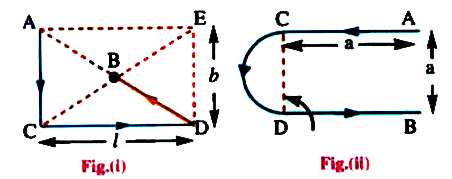If the distance travelled by a freely falling body in the last second of its journey is equal to the distance travelled in the first 2s, the time of descent of the body isSolution in Telugu
5s
1.5s
2.5s
3s
The correct Answer is:C
Step by step video, text & image solution for If the distance travelled by a freely falling body in the last second of its journey is equal to the distance travelled in the first 2s, the time of descent of the body is by Physics experts to help you in doubts & scoring excellent marks in Class 11 exams.
Topper's Solved these Questions
- BOOK - AAKASH SERIESCHAPTER - MOTION IN A STRAIGHT LINEEXERCISE - Exercise -331videos
MOTION IN A STRAIGHT LINE
- BOOK - AAKASH SERIESCHAPTER - MOTION IN A STRAIGHT LINEEXERCISE - PROBLEM47videos
MOTION IN A STRAIGHT LINE
- BOOK - AAKASH SERIESCHAPTER - MOTION IN A STRAIGHT LINEEXERCISE - Exercise 2A30videos
MOTION IN A STRAIGHT LINE
- BOOK - AAKASH SERIESCHAPTER - MOTION IN A PLANE EXERCISE - Practice Exercise84videos
MOTION IN A PLANE
- BOOK - AAKASH SERIESCHAPTER - NEWTONS LAWS OF MOTION EXERCISE - ADDITIONAL PRACTICE EXERCISE PRACTICE SHEET (ADVANECED) (Matrix Matching Type Questions)1videos
NEWTONS LAWS OF MOTION
Similar Questions
A particle traversed half of the distance with a velocity of V0. The remaining parts of the distance was covered with velocity V1 for half of the time and with V2 for other half of the time. Find the mean velocity of the particle averaged and the whole time of motion
01:57View SolutionFind the distance covered by the particles in the following figures,
and
while a particle travels from A to B as shown by the arrows
 03:19View Solution
03:19View Solution(A): Displacement of a body may be zero when distance travelled by it is not zero.
(R) : The displacement is the longest distance between initial and final positions..02:56View SolutionA person runs along a circular path of radius 5m. Find the magnitude of the displacement if he runs all the way around the circle ?
11:09View SolutionThe system shown in the figure is given an acceleration 'a' towards left. Assume all contact surfaces to be smooth (m: mass of the sphere) The magnitude of the contact force between wedge and sphere between wedge and sphere at A is xmg√3 then 'x' is
 03:48View Solution
03:48View SolutionIf a freely falling body travels in the last second, a distance equal to the distance travelled by it in the first three second, the time of the travel is
04:31View SolutionA freely falling body takes t second to travel (1/x)th distance then time of descent is
02:47View SolutionFind the ratio of the distances travelled by a freely falling body in first, second and third second of its fall.
04:25View SolutionIF a freely falling body covers halfs of its total distance in the last second of its journey. Find its time of fall
View SolutionA stone is falling freely. The distance travelled in the last second is equal to that travelled in the first three seconds. The time spent by the stone in air is
04:31View SolutionIf a freely falling body covers half of its total distance in the last second of its journey, Find its time of fall.
View SolutionIf the distance travelled by a freely falling body in the last second of its journey is equal to the distance travelled in the first 2s, the time of descent of the body is
View SolutionIf a freely body covers half of its total distance in the last second of its journey,Find its time of fall.
View SolutionIf the distance travelled by a freely falling body in the last second of its journey is equal to the distance travelled in the first 2s,the time of descent of the body is
View SolutionIf a freely falling body covers half of its total distance in the last second of its journey. Find its time of fall.
03:26View SolutionIf a freely falling body covers half of its total distance in the last second of its journey, Find its time of fall.
01:51View Solution

